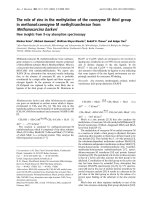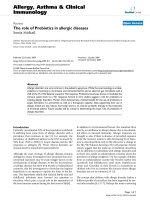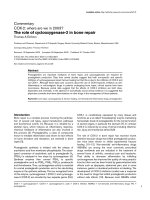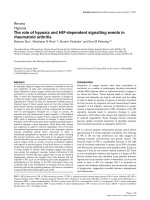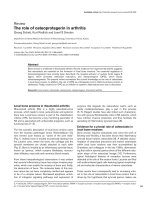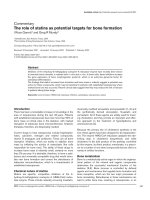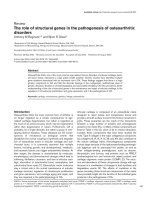Báo cáo y học: "The role of tumor necrosis factor-alpha in systemic lupus erythematosus" pdf
Bạn đang xem bản rút gọn của tài liệu. Xem và tải ngay bản đầy đủ của tài liệu tại đây (377.83 KB, 8 trang )
Page 1 of 8
(page number not for citation purposes)
Available online />Abstract
Murine models of systemic lupus erythematosus (SLE) have shown
apparently contradictory evidence in that either (a) tumor necrosis
factor (TNF) expression was low and TNF administration helpful or
(b) TNF was high and TNF blockade of therapeutic benefit, depen-
ding on the mouse model investigated. In fact, TNF apparently has
both effects, checking autoimmunity, at least to some degree, and
fostering inflammation. TNF blockade regularly, but transiently,
induces or increases autoantibodies to chromatin and to phospho-
lipids. At the same time, open-label data suggest that TNF block-
ade suppresses inflammatory manifestations of SLE, and long-term
benefit was seen in patients with lupus nephritis. A controlled
clinical trial is under way.
Tumor necrosis factor (TNF) exerts a variety of physiologic
and pathogenic effects [1-6]. For example, TNF plays a major
role in the organogenesis of the lymphoid system in early
development; it has pro-apoptotic and anti-apoptotic effects,
depending on the underlying contextual situation; it controls
the activation and responsiveness of many cells, including
cells of the immune system; and it is a master switch in the
initiation and perpetuation of inflammatory responses
(Figure 1). When the role of TNF and TNF inhibition in
systemic lupus erythematosus (SLE)–especially the latter two
effects–is examined, modulation of the immune (and auto-
immune) reactivity and pro-inflammatory effects have to be
considered. Therefore, these effects will constitute the focus
of the current review.
The role of tumor necrosis factor in
controlling autoimmunity
Autoreactivity is a common feature of healthy individuals, both
on the cellular and humoral levels [7,8]. However, this type of
autoimmunity is usually well controlled, is often only transient,
and does not lead to disease. In contrast, in autoimmune
diseases, autoimmunity has escaped its stringent control and
become pathogenic.
For SLE, there exist a variety of murine models. They differ in
parts of their phenotype and especially in the underlying
genetic factors, which lead to their disease. With respect to
TNF, it is of particular interest that this cytokine appears to
play an immunoregulatory role in lupus-prone animals
(Table 1). However, this role is not at all uniform, and TNF has
different consequences depending upon the strain and the
stage of the disease.
Tumor necrosis factor can ameliorate murine
lupus
In 1988, Jacob and McDevitt [9] reported that NZB/W mice
showed diminished production of TNF, a defect stemming
from the otherwise healthy NZW parent, and proved that
NZB/W disease was at least partly reversible by
administration of recombinant TNF early in life. Gordon and
colleagues [10], upon repeating and expanding these
studies, saw similar beneficial effects of high-dose TNF, even
after nephritis had developed, but there was no long-term
protection against the disease. Gordon and Wofsy [11] also
found that the recombinant TNF had effects on cellular, but
not humoral, (auto)immunity. More recently, Kontoyiannis and
Kollias [12], by analyzing TNF-deficient NZB mice, re-estab-
lished the finding that TNF deficiency is an important driver of
lupus-like autoimmunity in certain strains. Whereas TNF-
competent NZB mice display a subtle autoimmune phenotype
only, TNF-deficient NZB mice developed severe lupus.
Review
The role of tumor necrosis factor-alpha in systemic lupus
erythematosus
Martin Aringer
1
and Josef S Smolen
2
1
Division of Rheumatology, Department of Medicine III, University Clinical Center Carl Gustav Carus, Technical University of Dresden, Fetscherstrasse
74, 01307 Dresden, Germany
2
Department of Rheumatology, Internal Medicine III, Medical University of Vienna, Waehringer Guertel 18-20, 1090 Vienna, Austria
Corresponding author: Martin Aringer,
Published: 23 January 2008 Arthritis Research & Therapy 2008, 10:202 (doi:10.1186/ar2341)
This article is online at />© 2008 BioMed Central Ltd
ACLA = anti-cardiolipin-antibody; ANA = anti-nuclear antibody; CD = Crohn disease; CLIFT = Crithidia luciliae immunofluorescence test; dsDNA =
double-stranded DNA; IFN = interferon; Ig = immunoglobulin; MMF = mycophenolate mofetil; RA = rheumatoid arthritis; RIA = radioimmunoassay;
SCLE = subacute cutaneous lupus erythematosus; SLE = systemic lupus erythematosus; SpA = spondylarthropathy; TCR = T-cell receptor; TNF =
tumor necrosis factor; WHO = World Health Organization.
Page 2 of 8
(page number not for citation purposes)
Arthritis Research & Therapy Vol 10 No 1 Aringer and Smolen
Tumor necrosis factor can deteriorate murine
lupus
In contrast to the findings in NZB/W mice, in which the auto-
immune consequences of low TNF levels were profound, TNF
was found to be highly overexpressed in both sera and renal
tissue of MRL/lpr/lpr lupus mice and the levels of TNF corre-
lated with the degree of inflammatory organ disease [13,14].
Moreover, even in NZB/W mice, there is an increase in renal
TNF expression in conjunction with renal inflammation [15].
In fact, anti-TNF therapy was beneficial in MRL/lpr lupus.
TNF-targeted approaches improved inflammation in joints
[16] and lungs [17]. Likewise, TNF blockade improved
arthritis, pneumonitis, and skin disease of moth-eaten mice
[18] and nephritis and leukopenia in the C3H.SW mouse
[19], two additional lupus models. Of particular interest,
administration of low-dose TNF later in the course of NZB/W
disease accelerated renal demise [15], revealing that even in
this model, in which TNF was thought to be protective, the
cytokine has a dual role–beneficial and detrimental.
Autoantibodies under tumor necrosis factor
blockade in more organ-selective
autoimmune disease
When therapies that inhibited TNF, such as infliximab,
etanercept, and adalimumab, were introduced in patients with
rheumatoid arthritis (RA), spondylarthropathies (SpAs), or
Crohn disease (CD), the emergence of anti-nuclear anti-
bodies (ANAs) and anti-dsDNA (double-stranded DNA) was
observed [20-31].
New-onset ANAs were found in at least one fourth, and up to
two thirds, of ANA-negative patients, and this possibly
depended somewhat on the disease (Table 2). Auto-
antibodies to dsDNA, which are much more specific for SLE,
still emerged in 9% to 54% of the patients under infliximab
therapy, depending on the test system. By means of the
Crithidia luciliae immunofluorescence test (CLIFT), Charles
and colleagues [20] found anti-dsDNA in 22 of 156 patients
with RA (14%) whereas by radioimmunoassay (RIA) only 8
patients (5%) had clearly positive antibodies (>25 U/mL).
It is important to note that the vast majority of these anti-
dsDNA antibodies were of immunoglobulin (Ig) M isotype
(Table 1) and most probably were non-pathogenic. In contrast
to these IgM autoantibodies, the occurrence of IgG anti-
dsDNA antibodies appeared to be a relatively rare event.
However, these autoantibodies may be closely associated
with instances of SLE-like disease [20,27]. In this regard, it is
interesting that, whereas IgM anti-dsDNA autoantibodies were
found less frequently under TNF blockade with etanercept
[28], this compound induces lupus to an apparently similar
extent as antibodies to TNF [32]. In addition, formation of anti-
phospholipid antibodies, again mostly of IgM isotype, can
occur during TNF-inhibiting therapy [24,33] and very rarely
may lead to life-threatening vascular complications [33,34].
Drug-induced lupus and lupus nephritis under
tumor necrosis factor blockade
The induction of lupus-like disease by TNF blockers appears
to be quite uncommon, with an incidence of 0.5% to 1%
[20,25,35], and independent of the type of TNF-blocking
drug [32,36]. Moreover, TNF-blocker-induced lupus is usually
benign, with most patients developing fatigue or fever,
musculoskeletal or skin symptoms, changes in blood counts,
or serositis, but only rarely major organ disease, and these
symptoms resolve after TNF blockade is stopped [32,36].
Nevertheless, seven cases of nephritis occurring under anti-
TNF therapy have been reported [37-39]. Four of these cases
occurred under etanercept, two on infliximab, and one under
adalimumab. Of these seven patients, five treated with
etanercept or adalimumab had bona fide lupus nephritis.
Histology showed World Health Organization (WHO) class
IV (diffuse proliferative) glomerulonephritis in two cases and
class III and class V (membranous) nephritis in one case
each. One patient did not undergo renal biopsy. Despite
Figure 1
Relevant effects of tumor necrosis factor (TNF). TNF acts on the
hypothalamus to induce fever and on hepatocytes to induce an acute-
phase response, mainly via interleukin (IL)-1 and IL-6, respectively (blue
lines). TNF also exerts a wide variety of immunoregulatory (left) and
pro-inflammatory actions: TNF is involved in the maturation of dendritic
cells (DC) and activates endothelial cells (EC) and immune cells (black
lines). Chronic TNF often is a survival signal (green lines) and plays a
role in maintaining survival niches for long-lived plasma cells
(PlasmaC). Some of these effects are indirect in part, involving
cytokines such as IL-6 for B cells (B) and IL-18 for cytotoxic T cells
(Tc). On the other hand, chronic TNF exposure leads to the
disassembly of T-cell receptors (TCR), thus inhibiting T-cell responses,
and induces the expression of anti-apoptotic proteins, inhibiting
programmed cell death (red lines). Effects on many other cells, such as
fibroblasts or osteoclasts, were left out because of the focus on
immune regulation but are of major importance elsewhere. Ab,
antibodies; Ag, antigen; C’, complement; CR, complement receptors;
FcR, Fc receptor; IC, immune complex; MF, macrophage; MHC, major
histocompatibility complex; Th, T helper cell.
Page 3 of 8
(page number not for citation purposes)
these impressive histological findings, none of the five
patients had to undergo cyclophosphamide therapy, only one
was treated with mycophenolate mofetil (MMF) [39], and the
rest remitted under steroids and TNF blocker withdrawal only.
Available online />Table 1
Tumor necrosis factor (TNF) expression and effects of recombinant TNF administration or TNF blockade in murine models of
systemic lupus erythematosus
Model [Reference] TNF expression Effects of recombinant TNF Effects of TNF blockade/deficiency
NZB [12] Normal NA Severe lupus in TNF
–/–
animals
NZB/W [9,10] Low High dose: late onset (if given early), NA
prolonged survival
[15] High in nephritis Low dose (late): increased renal inflammation
MRL/lpr [13,14] High NA Improved arthritis, pneumonitis
Moth-eaten [18] High NA Improved skin, arthritis, pneumonitis
C3H.SW [19] High NA Less severe nephritis, leukocytopenia
NA, not assessed.
Table 2
Autoantibodies and drug-induced lupus under infliximab
New ANA New anti-dsDNA New ACLA
Diagnosis Number Positive Positive
a
IgM IgG IgM IgG DIL Reference
RA 156 37 (24%) 22 (14%) 22 1 ND ND 1 [20]
RA 62 19 (31%) 7 (11%) 7 0 ND ND 0 [22]
RA 24 4 (17%) 13 (54%) 9-11 3-4 5 0 0 [24]
RA 59 24 (41%) 21 (36%) 19 2 ND ND 0 [26]
RA 53 29 (55%) 5 (9%) 22
b
34
b
0 0 2 [27]
RA 59 24 (41%) 29 (49%) 28 1 0 0 0 [28]
RA 57 28 (49%) ND 3 ND ND 1 [31]
All RA 413 165 (40%) 77 (19%) 4 (1.0%)
AS 15 9 (60%) 4 (27%) 4 0-1 1 3 0 [24]
SpA 21 12 (57%) 4 (19%) ND ND ND ND 0 [21]
SpA 35 25 (71%) 6 (17%) 6 0 ND ND 0 [22]
SpA 33 8 (24%) 11 (33%) 11 0 ND ND 0 [29]
All SpA 94 54 (57%) 25 (27%) 0 (0%)
CD 35 6 (17%) 3 (9%) ND ND ND ND 0 [23]
CD 125 71 (57%) 14 (11%) ND ND ND ND 2 [25]
CD 500 ND ND ND ND ND ND 3 [35]
CD 63 21 (33%) 9 (14%) ND 9 2 0 1 [30]
All CD 723 6 (0.8%)
All together 1,230 10 (0.8%)
a
Radioimmunoassay or most conservative value reported;
b
values difficult to reconcile with the number of patients with anti-dsDNA antibodies as
measured by radioimmunoassay. ACLA, anti-cardiolipin antibodies; ANA, anti-nuclear antibodies; anti-dsDNA, antibodies to double-stranded DNA;
AS, ankylosing spondylitis; CD, Crohn disease; DIL, drug-induced lupus; Ig, immunoglobulin; ND, not determined/reported; RA, rheumatoid
arthritis; SpA, spondylarthropathies.
Rationale for using tumor necrosis factor
inhibition to treat systemic lupus
erythematosus
Most clinical manifestations of SLE are the consequence of
inflammatory changes subsequent to immune complex
formation with Fc receptor and complement activation. In the
sera of SLE, in contrast to many other diseases, such as RA,
in which the pathogenic role of TNF is established despite
the difficulty to readily detect increases in serum levels, TNF
reaches levels of more than 100 pg/mL; moreover, TNF con-
centrations are significantly associated with clinical disease
activity [40-44]. Despite the very high serum levels of soluble
TNF receptors, which likewise correlate with disease activity
[42,43,45], the TNF circulating in lupus sera is bioactive [46].
TNF is evidently overexpressed not only in murine (see
above), but also in human lupus nephritis [47-50], and our
own data suggest that this increase is associated with (renal)
disease activity as estimated by histology [51]. In addition,
TNF expression was demonstrated in refractory subacute
cutaneous lupus erythematosus (SCLE) lesions [52].
Given the role of TNF as a strong mediator of inflammation,
the high levels of serum TNF in active SLE, and the over-
expression in renal tissue with active nephritis, we reasoned
that TNF blockade could be an efficient way to block inflam-
mation in afflicted organs, such as the kidney, the joints, or
the skin. However, in view of the autoimmunogenic potential
of inhibiting TNF, we tested TNF inhibition as a means to
interfere with the inflammatory response in SLE by adminis-
tering only an induction regime of four infusions of infliximab
within 10 weeks rather than by planning for long-term therapy.
Evidence for beneficial effects from
open-label trial and anecdotal reports
Before we can embark upon summarizing reports on individual
or small groups of cases, a word of caution is mandated.
Anecdotal reports or open-label trials cannot be regarded as
providing evidence of the results they claim to reflect. If they
use some objective measure, the hints they give may be slightly
stronger, but the ultimate information has to come from
randomized controlled clinical trials [53]. On the other hand,
open-label studies in RA [54], ankylosing spondylitis [55], and
CD were subsequently confirmed by controlled trials.
Moreover, the potential risks of the approach and the
heterogeneity of SLE with its life-threatening features justified
an open-label study as a first step. Finally, open-label
experience with TNF blockade in a homogeneous subset of the
disease (such as nephritis) with the use of objective laboratory
measures (such as levels of creatinine or proteinuria) would
allow for focussing a controlled trial once they reveal beneficial
effects. From this perspective, we embarked upon an open-
label trial several years ago and complemented the data
obtained with the anecdotal reports on individual cases that
were published in the literature. Although the evidence for
therapeutic efficacy of TNF blockade in SLE is still limited,
there are a minimum of 28 cases reported at least in abstract
form [56-61] and most of these are on the use of the chimeric
monoclonal antibody infliximab.
Tumor necrosis factor blockade and lupus
arthritis
Our own experience includes three patients with refractory
lupus polyarthritis, all of whom went into complete remission
within days after the first (approximately 5 mg/kg) infusion of
infliximab [56]. Similar to RA, this effect lasted for about
8 weeks after the last infusion of a series of four. Retreatment
was effective for the relapsing disease in a single patient for
whom this approach was tried but led to a further increase in
anti-dsDNA autoantibodies [62]. All of our patients were on
constant dosages of either azathioprine or methotrexate, as
were patients successfully treated in Brussels [59] and Kuwait
[60]. In contrast, Katz and colleagues [63] saw a frequent
decline in efficacy and severe infusion reactions in patients
who were treated with infliximab without such combination
with conventional disease-modifying anti-rheumatic drugs.
Tumor necrosis factor blockade and skin
involvement
The published experience on lupus skin disease includes two
patients with SCLE [64,65] who were successfully treated
with the combination of infliximab and azathioprine and with
etanercept, respectively. We have also seen overt and long-
lasting improvement of a butterfly rash following compas-
sionate care treatment with infliximab and azathioprine in a
patient with lupus nephritis.
Tumor necrosis factor blockade and lupus
nephritis
Twelve published patients with SLE treated with TNF
blockers had lupus nephritis. Among them were seven
patients with diffuse proliferative (WHO class IV) [56,58,
59,61] and at least four with membranous (WHO class V)
lupus nephritis [56,57,59]. Most patients were treated with
the combination of infliximab with azathioprine or MMF. One
pregnant patient received etanercept plus plasmapheresis
and intravenous immunoglobulin [58].
In all but three patients, TNF blocker therapy led to significant
long-term renal responses. This may easily reflect reporting
bias, but in a series of nine patients with lupus nephritis, in
which all SLE patients of the cooperating centers were
included if they had ever received infliximab, the data still
amounted to a success rate of two out of three [59].
It is important to stress an unexpected finding in the patients
with lupus nephritis who were successfully treated with only
four infusions of infliximab (and constant-dose azathioprine).
In lupus arthritis, the disease relapsed within 2 months after
the last infusion, whereas in lupus nephritis, the improvement
achieved lasted for several years in some of the patients
[59,62]. In fact, many patients further improved their
Arthritis Research & Therapy Vol 10 No 1 Aringer and Smolen
Page 4 of 8
(page number not for citation purposes)
proteinuria over time, with stable normal or slightly improving
renal function [56]. These findings, which suggest self-
perpetuation of the inflammatory events which is interfered
with by TNF blockade, have yet to be understood in detail.
It is also noteworthy that severe edema in one case of long-
standing nephritic syndrome resolved within 2 weeks despite
a much slower increase in serum albumin [56], suggesting
direct effects on vessel permeability [66]. Thus, TNF
blockers, and infliximab in particular, appear to rapidly reduce
inflammation, and probably also reduce vascular permeability,
in patients with inflammatory manifestations of SLE.
Autoantibodies under tumor necrosis factor
blockade in patients with systemic lupus
erythematosus
While dampening inflammation, TNF blockade with infliximab
induced an increase of autoantibodies in five out of seven
patients and increases in anti-cardiolipin-antibodies (ACLAs)
in four out of seven patients in our open-label trial [62,67].
Moreover, we observed increases in autoantibodies to
histones and/or chromatin in all seven patients, including
those without anti-dsDNA antibodies [62]. At least in part, the
increase in anti-histone and anti-chromatin antibodies
preceded the anti-dsDNA increase.
All of these antibodies were only transiently elevated and fell
back to baseline levels shortly after TNF blockade was
stopped. None of the patients experienced a lupus flare, and
serum complement levels remained stable [62,67].
Nevertheless, the induced antibodies to dsDNA were of high
affinity, as measured by RIA, and of IgG isotype, as deter-
mined by CLIFT. Although this could have been expected
given the preformed anti-dsDNA antibodies, the absence of
lupus flares requires clarification. Several explanations are
possible. First, at the time of inclusion into this study, some
patients may have had a non-pathogenic autoantibody profile,
which, even when activated and expanded, remained non-
pathogenic. Second, the increase in autoantibody levels was
only transient, whereas the longer-term presence of high
levels of pathogenic antibodies might be required to induce
complement activation and flares; such a notion is supported
by observations on the long-term presence of anti-dsDNA
antibodies before the onset of SLE symptoms [68]. Third, the
pronounced anti-inflammatory effects of infliximab may have
prevented damage despite the presence of potentially
pathogenic antibodies. Nevertheless, we have observed one
episode of deep vein thrombosis in temporal association with
a slight increase in ACLA in one patient with preformed IgG
ACLA [59], indicating that in individual patients the presence
of autoantibodies may be associated with clinical pathology.
Potential mechanisms of autoantibody
formation under tumor necrosis factor blockade
Several hypotheses have been proposed which may explain,
at least in part, how a (therapeutic) reduction in TNF activity
could lead to formation of autoantibodies against nuclear
components and phospholipids. One of these hypotheses
relates to the activation of interferon (IFN)-α. Because, under
normal circumstances, TNF downregulates IFN-α [69], it was
hypothesized that the reduction in TNF unleashed IFN-α, thus
fostering autoimmunity. However, in SLE, both IFN-α and TNF
are highly increased and the levels of both of these cytokines
are associated with disease activity [40-42,44]. This finding
not only challenges the hypothesis, but even suggests that
the reciprocal negative regulation of the two cytokines is not
functional in active SLE. Rather, the combined increase of
both TNF and IFN-α might contribute to the pathogenesis of
systemic autoimmunity.
Another hypothesis relates to prolonged B-cell survival upon
TNF inhibition. In a murine graft-versus-host disease system,
TNF blockade led to diminished production of IFN-γ,
diminished IFN-γ-induced CD95 (Fas) upregulation, and
diminished cytolytic activity, but to a significant increase in
anti-dsDNA antibodies [70]. This led the authors to hypothe-
size that TNF blockade hampers the elimination of auto-
immune B lymphocytes by cytotoxic T cells [70]. Because IL-
18, formerly called IFN-γ-inducing factor, is reduced by TNF
blockade in RA as well as in SLE [51,71], this mechanism
may play a role.
Chronic TNF exposure also directly impairs T-cell activation
by downmodulating T-cell receptor (TCR) components,
impairing TCR signalling, and attenuating antigen-driven
events [72,73]. Thus, inhibition of TNF may facilitate T-cell
activation. Finally, TNF blockade after chronic TNF exposure
may also lead to increased apoptosis [62]. The resulting
increase in apoptotic material could explain why the emerging
antibodies appear to exclusively target nuclear antigens and
phospholipids, both of which are expressed on apoptotic
bodies [74,75]. Thus, the combination of an increase in
accessible antigen, normalization in TCR function, and better
B-cell activation may help to explain the pathways to
increased lupus autoantibodies under TNF blockade.
Safety issues of tumor necrosis factor blocker
therapy for systemic lupus erythematosus
In our limited experience, treatment with only four infusions of
infliximab in combination with azathioprine or methotrexate
appeared to be fairly safe with regard to lupus flares [56]
despite the increase of autoantibodies [62]. However,
although it may hold true that the strong anti-inflammatory
effects of infliximab protect against the transient increase in
autoantibodies, occasional flares might well occur when more
patients are treated. Looking at potential consequences of a
likewise transient increase in ACLA, we have actually seen
one (single) episode of deep vein thrombosis [59], alerting to
such a possibility.
On the other hand, we did observe bacterial infections. Even
under short-term therapy (four infusions), we have seen a
Available online />Page 5 of 8
(page number not for citation purposes)
number of urinary tract infections, one leading to bacteremia,
and an occasional episode of enteritis caused by Salmonella
enteritidis [59]. Longer-term therapy may in fact expose
patients to higher risks in this respect [59].
Infusion reactions were not seen when infliximab was
combined with azathioprine (or methotrexate). Only a single
episode occurred in a patient retreated 1.5 years after
cessation of infliximab [59]. This is likely due to the
combination given that others have regularly observed severe
infusion reactions in lupus arthritis patients for whom
infliximab was used in monotherapy [63].
Controlled trial of infliximab and azathioprine
in membranous lupus nephritis
These data indicate that short-term TNF blockade in
combination with azathioprine may be a step forward in the
therapy of patients with lupus nephritis. However, substantial
evidence can be derived only from a controlled clinical trial.
We recently embarked on a double-blind placebo-controlled
study called ‘TNF blockade with Remicade in Active Lupus
nephritis class V’, or TRIAL V. This study includes patients
with membranous lupus nephritis (WHO class V) in whom
corticosteroids and angiotensin-converting enzyme inhibitors
have failed to reduce proteinuria below 3 g/day. Patients are
randomly assigned either to the combination of azathioprine
plus four infusions (5 mg/kg) of infliximab or to azathioprine
monotherapy plus four placebo infusions (Figure 2). The
primary endpoint is time to reduction in proteinuria below
1.5 g/day.
Conclusion
Although our understanding of TNF in SLE has increased
considerably over the past few years, novel findings are well
in line with what had to be predicted from previous mouse
studies. On the one hand, TNF apparently has anti-
autoimmune effects and TNF blockade may lead to the
occurrence of autoantibodies. Whereas drug-induced lupus-
like disease is an uncommon, but established, adverse effect
of TNF blockade in patients with RA, SpA, or CD, these
autoantibodies hitherto have not induced lupus flares. On the
other hand, TNF appears to play a major pro-inflammatory
role in SLE also. The available open-label experience on
infliximab therapy in SLE suggests that, in combination with
azathioprine, infliximab may turn out to be an interesting
therapeutic option in selected patients with SLE and in
particular in those with nephritis. It will depend on controlled
clinical trials to decide this point. At least one such trial is
under way.
Competing interests
Both authors have received a research grant from Centocor
for laboratory studies and Centocor also funds the controlled
trial. JSS has also received occasional advisory fees from
Centocor and other companies marketing TNF blockers.
References
1. Theofilopoulos AN, Lawson BR: Tumour necrosis factor and
other cytokines in murine lupus. Ann Rheum Dis 1999, 58
Suppl 1:I49-I55.
2. McDevitt H, Munson S, Ettinger R, Wu A: Multiple roles for
tumor necrosis factor-alpha and lymphotoxin alpha/beta in
immunity and autoimmunity. Arthritis Res 2002, 4:S141-S152.
3. Mageed RA, Isenberg DA: Tumour necrosis factor alpha in sys-
temic lupus erythematosus and anti-DNA autoantibody pro-
duction. Lupus 2002, 11:850-855.
4. Aringer M, Smolen JS: Complex cytokine effects in a complex
autoimmune disease: tumor necrosis factor in systemic lupus
erythematosus. Arthritis Res Ther 2003, 5:172-177.
5. Suryaprasad AG, Prindiville T: The biology of TNF blockade.
Autoimmun Rev 2003, 2:346-357.
6. Kollias G: TNF pathophysiology in murine models of chronic
inflammation and autoimmunity. Semin Arthritis Rheum 2005,
34:3-6.
7. Coutinho A, Kazatchkine MD, Avrameas S: Natural autoantibod-
ies. Curr Opin Immunol 1995, 7:812-818.
8. Schwartz M, Cohen IR: Autoimmunity can benefit self-mainte-
nance. Immunol Today 2000, 21:265-268.
9. Jacob CO, McDevitt HO: Tumour necrosis factor-alpha in murine
autoimmune ‘lupus’ nephritis. Nature 1988, 331:356-358.
10. Gordon C, Ranges GE, Greenspan JS, Wofsy D: Chronic
therapy with recombinant tumor necrosis factor-alpha in
autoimmune NZB/NZW F1 mice. Clin Immunol Immunopathol
1989, 52:421-434.
11. Gordon C, Wofsy D: Effects of recombinant murine tumor
necrosis factor-alpha on immune function. J Immunol 1990,
144:1753-1758.
12. Kontoyiannis D, Kollias G: Accelerated autoimmunity and lupus
nephritis in NZB mice with an engineered heterozygous defi-
ciency in tumor necrosis factor. Eur J Immunol 2000, 30:2038-
2047.
Arthritis Research & Therapy Vol 10 No 1 Aringer and Smolen
Page 6 of 8
(page number not for citation purposes)
Figure 2
Graphic representation of the study plan of the ongoing TRIAL V
(Tumor necrosis factor blockade with Remicade In Active Lupus
nephritis class V) randomized placebo-controlled clinical trial. More
details can be found at [76]. ACE, angiotensin-converting enzyme;
WHO, World Health Organization.
13. Boswell JM, Yui MA, Burt DW, Kelley VE: Increased tumor
necrosis factor and IL-1 beta gene expression in the kidneys
of mice with lupus nephritis. J Immunol 1988, 141:3050-3054.
14. Yokoyama H, Kreft B, Kelley VR: Biphasic increase in circulating
and renal TNF-alpha in MRL-lpr mice with differing regulatory
mechanisms. Kidney Int 1995, 47:122-130.
15. Brennan DC, Yui MA, Wuthrich RP, Kelley VE: Tumor necrosis
factor and IL-1 in New Zealand Black/White mice. Enhanced
gene expression and acceleration of renal injury. J Immunol
1989, 143:3470-3475.
16. Edwards CK, III, Zhou T, Zhang J, Baker TJ, De M, Long RE,
Borcherding DR, Bowlin TL, Bluethmann H, Mountz JD: Inhibition
of superantigen-induced proinflammatory cytokine produc-
tion and inflammatory arthritis in MRL-lpr/lpr mice by a tran-
scriptional inhibitor of TNF-alpha. J Immunol 1996, 157:
1758-1772.
17. Deguchi Y, Kishimoto S: Tumour necrosis factor/cachectin
plays a key role in autoimmune pulmonary inflammation in
lupus-prone mice. Clin Exp Immunol 1991, 85:392-395.
18. Su X, Zhou T, Yang P, Edwards CK, Mountz JD: Reduction of
arthritis and pneumonitis in motheaten mice by soluble tumor
necrosis factor receptor. Arthritis Rheum 1998, 41:139-149.
19. Segal R, Dayan M, Zinger H, Mozes E: Suppression of experi-
mental systemic lupus erythematosus (SLE) in mice via TNF
inhibition by an anti-TNFalpha monoclonal antibody and by
pentoxiphylline. Lupus 2001, 10:23-31.
20. Charles PJ, Smeenk RJ, De Jong J, Feldmann M, Maini RN:
Assessment of antibodies to double-stranded DNA induced in
rheumatoid arthritis patients following treatment with inflix-
imab, a monoclonal antibody to tumor necrosis factor alpha:
findings in open-label and randomized placebo-controlled
trials. Arthritis Rheum 2000, 43:2383-2390.
21. Kruithof E, Van Den BF, Baeten D, Herssens A, De Keyser F,
Mielants H, Veys EM: Repeated infusions of infliximab, a
chimeric anti-TNFalpha monoclonal antibody, in patients with
active spondyloarthropathy: one year follow up. Ann Rheum
Dis 2002, 61:207-212.
22. De Rycke L, Kruithof E, Van Damme N, Hoffman IE, Van den BN,
Van Den BF, Veys EM, De Keyser F: Antinuclear antibodies fol-
lowing infliximab treatment in patients with rheumatoid arthri-
tis or spondylarthropathy. Arthritis Rheum 2003, 48:
1015-1023.
23. Garcia-Planella E, Domenech E, Esteve-Comas M, Bernal I, Cabre
E, Boix J, Gassull MA: Development of antinuclear antibodies
and its clinical impact in patients with Crohn’s disease treated
with chimeric monoclonal anti-TNFalpha antibodies (inflix-
imab). Eur J Gastroenterol Hepatol 2003, 15:351-354.
24. Ferraro-Peyret C, Coury F, Tebib JG, Bienvenu J, Fabien N: Inflix-
imab therapy in rheumatoid arthritis and ankylosing spondyli-
tis-induced specific antinuclear and antiphospholipid
autoantibodies without autoimmune clinical manifestations: a
two-year prospective study. Arthritis Res Ther 2004, 6:R535-
R543.
25. Vermeire S, Noman M, Van Assche G, Baert F, Van Steen K,
Esters N, Joossens S, Bossuyt X, Rutgeerts P: Autoimmunity
associated with anti-tumor necrosis factor alpha treatment in
Crohn’s disease: a prospective cohort study. Gastroenterology
2003, 125:32-39.
26. Allanore Y, Sellam J, Batteux F, Job DC, Weill B, Kahan A: Induc-
tion of autoantibodies in refractory rheumatoid arthritis
treated by infliximab. Clin Exp Rheumatol 2004, 22:756-758.
27. Eriksson C, Engstrand S, Sundqvist KG, Rantapaa-Dahlqvist S:
Autoantibody formation in patients with rheumatoid arthritis
treated with anti-TNF alpha. Ann Rheum Dis 2005, 64:403-407.
28. De Rycke L, Baeten D, Kruithof E, Van Den BF, Veys EM, De
Keyser F: Infliximab, but not etanercept, induces IgM anti-
double-stranded DNA autoantibodies as main antinuclear
reactivity: biologic and clinical implications in autoimmune
arthritis. Arthritis Rheum 2005, 52:2192-2201.
29. Sellam J, Allanore Y, Batteux F, Deslandre CJ, Weill B, Kahan A:
Autoantibody induction in patients with refractory spondy-
loarthropathy treated with infliximab and methotrexate. Joint
Bone Spine 2005, 72:48-52.
30. Atzeni F, Ardizzone S, Sarzi-Puttini P, Colombo E, Maconi G, De
PS, Carrabba M, Bianchi PG: Autoantibody profile during short-
term infliximab treatment for Crohn’s disease: a prospective
cohort study. Aliment Pharmacol Ther 2005, 22:453-461.
31. Comby E, Tanaff P, Mariotte D, Costentin-Pignol V, Marcelli C,
Ballet JJ: Evolution of antinuclear antibodies and clinical pat-
terns in patients with active rheumatoid arthritis with
longterm infliximab therapy. J Rheumatol 2006, 33:24-30.
32. De Bandt M, Sibilia J, Le L, X, Prouzeau S, Fautrel B, Marcelli C,
Boucquillard E, Siame JL, Mariette X: Systemic lupus erythe-
matosus induced by anti-tumour necrosis factor alpha
therapy: a French national survey. Arthritis Res Ther 2005,
7:R545-R551.
33. Ferraccioli GF, Assaloni R, Di Poi E, Gremese E, De Marchi G,
Fabris M: Rescue of combination therapy failures using inflix-
imab, while maintaining the combination or monotherapy with
methotrexate: results of an open trial. Rheumatology (Oxford)
2002, 41:1109-1112.
34. Ferraccioli GF, Assaloni R, Perin A: Drug-induced systemic
lupus erythematosus and TNF-alpha blockers. Lancet 2002,
360:645.
35. Colombel JF, Loftus EV Jr., Tremaine WJ, Egan LJ, Harmsen WS,
Schleck CD, Zinsmeister AR, Sandborn WJ: The safety profile of
infliximab in patients with Crohn’s disease: the Mayo clinic
experience in 500 patients. Gastroenterology 2004, 126:19-31.
36. Ramos-Casals M, Brito-Zeron P, Munoz S, Soria N, Galiana D,
Bertolaccini L, Cuadrado MJ, Khamashta MA: Autoimmune dis-
eases induced by TNF-targeted therapies: analysis of 233
cases. Medicine (Baltimore) 2007, 86:242-251.
37. Carlson E, Rothfield N: Etanercept-induced lupus-like syn-
drome in a patient with rheumatoid arthritis. Arthritis Rheum
2003, 48:1165-1166.
38. Mor A, Bingham C III, Barisoni L, Lydon E, Belmont HM: Prolifera-
tive lupus nephritis and leukocytoclastic vasculitis during
treatment with etanercept. J Rheumatol 2005, 32:740-743.
39. Stokes MB, Foster K, Markowitz GS, Ebrahimi F, Hines W,
Kaufman D, Moore B, Wolde D, D’Agati VD: Development of
glomerulonephritis during anti-TNF-alpha therapy for
rheumatoid arthritis. Nephrol Dial Transplant 2005, 20:1400-
1406.
40. Maury CP, Teppo AM: Tumor necrosis factor in the serum of
patients with systemic lupus erythematosus. Arthritis Rheum
1989, 32:146-150.
41. Studnicka-Benke A, Steiner G, Petera P, Smolen JS: Tumour
necrosis factor alpha and its soluble receptors parallel clinical
disease and autoimmune activity in systemic lupus erythe-
matosus. Br J Rheumatol 1996, 35:1067-1074.
42. Gabay C, Cakir N, Moral F, Roux-Lombard P, Meyer O, Dayer JM,
Vischer T, Yazici H, Guerne PA: Circulating levels of tumor
necrosis factor soluble receptors in systemic lupus erythe-
matosus are significantly higher than in other rheumatic dis-
eases and correlate with disease activity. J Rheumatol 1997,
24:303-308.
43. Davas EM, Tsirogianni A, Kappou I, Karamitsos D, Economidou I,
Dantis PC: Serum IL-6, TNFalpha, p55 srTNFalpha, p75srTN-
Falpha, srIL-2alpha levels and disease activity in systemic
lupus erythematosus. Clin Rheumatol 1999, 18:17-22.
44. Aringer M, Stummvoll GH, Steiner G, Koller M, Steiner CW,
Hofler E, Hiesberger H, Smolen JS, Graninger WB: Serum inter-
leukin-15 is elevated in systemic lupus erythematosus.
Rheumatology (Oxford) 2001, 40:876-881.
45. Aderka D, Wysenbeek A, Engelmann H, Cope AP, Brennan F,
Molad Y, Hornik V, Levo Y, Maini RN, Feldmann M: Correlation
between serum levels of soluble tumor necrosis factor recep-
tor and disease activity in systemic lupus erythematosus.
Arthritis Rheum 1993, 36:1111-1120.
46. Aringer M, Feierl E, Steiner G, Stummvoll GH, Höfler E, Steiner
CW, Radda I, Smolen JS, Graninger WB: Increased bioactive
TNF in human systemic lupus erythematosus: associations
with cell death. Lupus 2002, 11:102-108.
47. Takemura T, Yoshioka K, Murakami K, Akano N, Okada M, Aya N,
Maki S: Cellular localization of inflammatory cytokines in
human glomerulonephritis. Virchows Arch 1994, 424:459-464.
48. Malide D, Russo P, Bendayan M: Presence of tumor necrosis
factor alpha and interleukin-6 in renal mesangial cells of
lupus nephritis patients. Hum Pathol 1995, 26:558-564.
49. Neale TJ, Ruger BM, Macaulay H, Dunbar PR, Hasan Q, Bourke
A, Murray-McIntosh RP, Kitching AR: Tumor necrosis factor-
alpha is expressed by glomerular visceral epithelial cells in
human membranous nephropathy. Am J Pathol 1995, 146:
1444-1454.
Available online />Page 7 of 8
(page number not for citation purposes)
50. Herrera-Esparza R, Barbosa-Cisneros O, Villalobos-Hurtado R,
Avalos-Diaz E: Renal expression of IL-6 and TNFalpha genes in
lupus nephritis. Lupus 1998, 7:154-158.
51. Aringer M, McInnes IB, Steiner G, Soleiman A, Stöckl-Hiesleitner
S, Hoefler E, Meyer B, Ulrich W, Smolen JS: TNF and inter-
leukin-18 (IL-18) upregulation in kidneys and sera of patients
with active systemic lupus erythematosus [abstract]. Ann
Rheum Dis 2007, 66:108.
52. Zampieri S, Alaibac M, Iaccarino L, Rondinone R, Ghirardello A,
Sarzi-Puttini P, Peserico A, Doria A: Tumour necrosis factor
alpha is expressed in refractory skin lesions from patients
with subacute cutaneous lupus erythematosus. Ann Rheum
Dis 2006, 65:545-548.
53. Smolen JS, Strand V, Cardiel M, Edworthy S, Furst D, Gladman D,
Gordon C, Isenberg DA, Klippel JH, Petri M, et al.: Randomized
clinical trials and longitudinal observational studies in sys-
temic lupus erythematosus: consensus on a preliminary core
set of outcome domains. J Rheumatol 1999, 26:504-507.
54. Elliott MJ, Maini RN, Feldmann M, Long-Fox A, Charles P, Bijl H,
Woody JN: Repeated therapy with monoclonal antibody to
tumour necrosis factor alpha (cA2) in patients with rheuma-
toid arthritis. Lancet 1994, 344:1125-1127.
55. Brandt J, Haibel H, Cornely D, Golder W, Gonzalez J, Reddig J,
Thriene W, Sieper J, Braun J: Successful treatment of active
ankylosing spondylitis with the anti-tumor necrosis factor
alpha monoclonal antibody infliximab. Arthritis Rheum 2000,
43:1346-1352.
56. Aringer M, Graninger WB, Steiner G, Smolen JS: Safety and effi-
cacy of TNFa blockade in systemic lupus erythematosus - an
open label study. Arthritis Rheum 2004, 50:3161-3169.
57. Gonzalez CM, Lopez-Longo FJ, Monteagudo I, Vazquez-Coleman
J, Montoro M, Ortega C, Nuno L, Gonzalez-Diaz de Rabago E, de
la Torre-Ortega I, Carreno L: Anti-TNF agents are effective and
safe in the management of systemic lupus erythematosus
[abstract]. Arthritis Rheum 2004, 50:S412.
58. Micheloud D, Nuno L, Rodriguez-Mahou M, Sanchez-Ramon S,
Ortega MC, Aguaron A, Junco E, Carbone J, Fernandez-Cruzl E,
Carreno L, et al.: Efficacy and safety of Etanercept, high-dose
intravenous gammaglobulin and plasmapheresis combined
therapy for lupus diffuse proliferative nephritis complicating
pregnancy. Lupus 2006, 15:881-885.
59. Aringer M, Houssiau F, Graninger WB, Feierl E, Steiner G,
Smolen JS: Long term safety and efficacy of open-label inflix-
imab for SLE [abstract]. Ann Rheum Dis 2007, 66:455.
60. Hayat SJ, Uppal SS: Therapeutic efficacy and safety profile of
infliximab in active systemic lupus erythematosus. Mod
Rheumatol 2007, 17:174-177.
61. Hayat SJ, Uppal SS, Narayanan Nampoory MR, Johny KV, Gupta
R, Al-Oun M: Safety and efficacy of infliximab in a patient with
active WHO class IV lupus nephritis. Clin Rheumatol 2007, 26:
973-975.
62. Aringer M, Steiner G, Graninger WB, Hofler E, Steiner CW,
Smolen JS: Effects of short-term infliximab therapy on autoan-
tibodies in systemic lupus erythematosus. Arthritis Rheum
2007, 56:274-279.
63. Katz RS, Holt-Daly N, MacDonald PA: Frequent infusion reac-
tions associated with infliximab treatment in patients with pol-
yarthritis related to systemic lupus erythematosus [abstract].
Arthritis Rheum 2003, 48:S379.
64. Hiepe F, Bruns A, Feist E, Burmester GR: Successful treatment
of a patient suffering from a refractory subacute cutaneous
lupus erthematosus (SCLE) with blockers of tumour necrosis
factor a [abstract]. Arthritis Rheum 2004, 50:S413.
65. Norman R, Greenberg RG, Jackson JM: Case reports of etaner-
cept in inflammatory dermatoses. J Am Acad Dermatol 2006,
54:S139-S142.
66. Lejeune FJ: Clinical use of TNF revisited: improving penetra-
tion of anti-cancer agents by increasing vascular permeability.
J Clin Invest 2002, 110:433-435.
67. Aringer M, Graninger WB, Steiner G, Smolen JS: Safety and effi-
cacy of tumor necrosis factor alpha blockade in systemic
lupus erythematosus: an open-label study. Arthritis Rheum
2004, 50:3161-3169.
68. Arbuckle MR, McClain MT, Rubertone MV, Scofield RH, Dennis
GJ, James JA, Harley JB: Development of autoantibodies
before the clinical onset of systemic lupus erythematosus. N
Engl J Med 2003, 349:1526-1533.
69. Palucka AK, Blanck JP, Bennett L, Pascual V, Banchereau J:
Cross-regulation of TNF and IFN-alpha in autoimmune dis-
eases. Proc Natl Acad Sci U S A 2005, 102:3372-3377.
70. Via CS, Shustov A, Rus V, Lang T, Nguyen P, Finkelman FD: In
vivo neutralization of TNF-alpha promotes humoral autoim-
munity by preventing the induction of CTL. J Immunol 2001,
167:6821-6826.
71. Pittoni V, Bombardieri M, Spinelli FR, Scrivo R, Alessandri C,
Conti F, Spadaro A, Valesini G: Anti-tumour necrosis factor
(TNF) alpha treatment of rheumatoid arthritis (infliximab)
selectively down regulates the production of interleukin (IL)
18 but not of IL12 and IL13. Ann Rheum Dis 2002, 61:723-725.
72. Cope AP, Londei M, Chu NR, Cohen SB, Elliott MJ, Brennan FM,
Maini RN, Feldmann M: Chronic exposure to tumor necrosis
factor (TNF) in vitro impairs the activation of T cells through
the T cell receptor/CD3 complex; reversal in vivo by anti-TNF
antibodies in patients with rheumatoid arthritis. J Clin Invest
1994, 94:749-760.
73. Isomaki P, Panesar M, Annenkov A, Clark JM, Foxwell BM, Cher-
najovsky Y, Cope AP: Prolonged exposure of T cells to TNF
down-regulates TCR zeta and expression of the TCR/CD3
complex at the cell surface. J Immunol 2001, 166:5495-5507.
74. Casciola-Rosen L, Rosen A, Petri M, Schlissel M: Surface blebs
on apoptotic cells are sites of enhanced procoagulant activity:
implications for coagulation events and antigenic spread in
systemic lupus erythematosus. Proc Natl Acad Sci U S A
1996, 93:1624-1629.
75. Utz PJ, Hottelet M, Schur PH, Anderson P: Proteins phosphory-
lated during stress-induced apoptosis are common targets
for autoantibody production in patients with systemic lupus
erythematosus. J Exp Med 1997, 185:843-854.
76. ClinicalTrials.gov home page [].
Arthritis Research & Therapy Vol 10 No 1 Aringer and Smolen
Page 8 of 8
(page number not for citation purposes)


